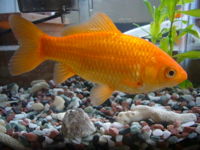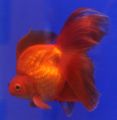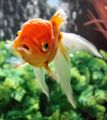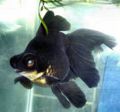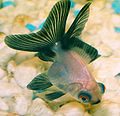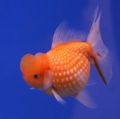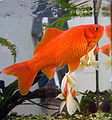Goldfish (Carassius auratus)
From The Aquarium Wiki
Goldfish
Carassius auratus
208 Litres (55 US G.)
20.3-35.6cm (8-14 ")
Freshwater
6.5 - 8.0
10 -25 °C (50-77°F)
5-25 °d
1:2 M:F
10-35 years
Family
Cyprinidae
This animal is available captive bred
Contents
- 1 Additional names
- 2 Origin
- 3 Sexing
- 4 Tank compatibility
- 5 Diet
- 6 Feeding regime
- 7 Environment specifics
- 8 Behaviour
- 9 Identification
- 9.1 Fancy Goldfish
- 9.1.1 Veil Tail
- 9.1.2 Ryunkins (Ryukin)
- 9.1.3 Orandas
- 9.1.4 Telescope/Globe Eye
- 9.1.5 Moors
- 9.1.6 Panda Moor
- 9.1.7 Fan Tail
- 9.1.8 Bubble-Eye
- 9.1.9 Celestial
- 9.1.10 Pearlscale
- 9.1.11 Hamanishiki/Crown Pearlscale
- 9.1.12 Demekin
- 9.1.13 Eggfish
- 9.1.14 Lionhead
- 9.1.15 Ranchu
- 9.1.16 PomPom
- 9.1.17 Wakin
- 9.1.18 Jikin
- 9.1.19 Tosakin
- 9.1.20 Man-yu
- 9.2 Common Goldfish
- 9.1 Fancy Goldfish
- 10 Special notes
- 11 Videos
- 12 References
- 13 External links
Additional names
- Fantail Goldfish, Common Goldfish, Comet Goldfish, Shubunkin, Fancy Goldfish
Additional scientific names
- Carassius auratus auratus
Origin
- Goldfish are ornamental fish and not found in wild waterways, unless they have been introduced. The Goldfish was selectively bred for color, body type, shape, and other traits, from Crucian Carp over hundreds of years and is now considered it's own different species.
Sexing
- Males develop breeding tubercles on their gill covers and on the leading ray of their pectoral fins. Females may have rounder convex vents while males have thinner concave vents. It is only possible to sex Goldfish when they are mature (over a year old) and usually only when it's their breeding season, which is in the springtime (although it has been known for some fish to show signs at other times of year).
Tank compatibility
- It is generally recommended to keep Goldfish in a species only tank as they can be bullies, nippy or victims to other fish as they are slow moving and the Fancies are delicate due to their stunted and deformed bodies. Fancy Goldfish should NOT be mixed with Common/Comet type Goldfish for this reason, a Common type is capable of injuring or even killing a Fancy, as well as out competing it to food.
- Common Plecos are NOT good tankmates for Goldfish as Plecos are not only tropical fish but have a difficult time getting enough to eat and, given they are nocturnal, they may also latch onto Goldfish while they are sleeping. This will harm the Goldfish and leave it open to infections and parasites.
- Other Catfish such as Otos and Corydoras also do NOT make good tank mates. Otos can develop a taste for a Goldfish's slime coat, as can many other suckermouth catfish and Loaches, but both these types of fish can also be eaten by Goldfish. Both Otos and Corys have spines, poisonous in Corys, which can cause them to get lodged in the throat of larger fish, including Goldfish, causing the death of both.
Diet
- Goldfish are omnivores and should be fed a balanced diet that includes fresh foods. Select fresh foods that are low in starches and sugars, e.g. shrimp, oysters, crab, clams for protein and vegetables such as peas, green beans, lima beans (butter beans), greens (e.g. spinach, collard, mustard, turnip, kale), squash, etc. They will also benefit from occasional live foods like worms, snails, small insects and aquatic plants (e.g. duckweed, azolla or salvinia) and algae.
- When feeding Goldfish pellets or flakes, do not feed it floating on the surface, it must sink before it's safe for the Goldfish to eat it. Gulping air at the same time as it eats the food can result in serious digestive disorders.
- Note - Fancy goldfish have a distorted indigestion system, so need food which is low in protein, starch and sugar as they get older. Constipation is a real concern with these type of goldfish. So be very careful that you don't over feed this fish. Never give it more than it can eat within a few minutes. Try the gel diet foods like 58LK or 5ML6 which are excellent.
Feeding regime
- Adults - Should be fed an amount of food they can eat in 2-3 minutes. Any excess should be removed.
- For outdoor goldfish, when temperature drops to below 10°C (50°F) do not feed.
Environment specifics
- Goldfish should NEVER be kept in unfiltered bowl environments. This is not a suitable home for any living creature.
- Fancy Goldfish need at least 114 Litres (30 US G.) per Goldfish and Common Goldfish are best kept in ponds of at least 568 Litres (150 US G.), with every fish needing at least 208 Litres (55 US G.) each, if not 284 Litres (75 US G.) each. If well cared for, Fancies can get around 20.3cm (8") long and Commons over 30.5cm (12"), so adequate room for swimming and turning is also necessary, another reason why Commons should really be kept in ponds and not indoor tanks.
- Common Goldfish can be kept outdoors if the pond doesn't freeze or drop below 5°C (41°F) . Fancy Goldfish will not tolerate colder temperatures as they are more delicate (more prone to fin rot) and will prove to be easy picking for passing predators such as Herons and domestic Cats.
Behaviour
- Very sociable and generally peaceful, except when spawning. When spawning, males chase and bump the female causing her to release eggs which the male fertilizes. Attention to water quality is important after spawning as it may cause ammonia to spike from all the protein in the water.
Identification
- See the pictures and descriptions below for all the different varieties of Goldfish.
Fancy Goldfish
Short-Bodied and Double-Tailed.
Veil Tail
- Very round-bodied with a long, flowing "veil" tail, colour metallic or calico.
Ryunkins (Ryukin)
- Half-way between the Veil-Tail and Fan-Tail with a deep body. Tail varies in length with a pointed head and a dorsal hump.
Orandas
- A Veil-Tail with a raspberry-like growth on the head called a 'hood' or 'wen'.
Telescope/Globe Eye
- The same as a Veil-Tail but with protruding 'bubble' eyes. Available in all colours except black, see below.
Moors
- Believed to be bred as far back as 1592 in China.
- The same as a Telescope but with protruding 'bubble' eyes and coloured deep velvety black. Can develop other colours as the colour black is not stable in Goldfish, it would then be called a Telescope Goldfish.
- Also known as Chinese Dragon-eye Goldfish.[1]
Panda Moor
A relatively new morph of the Black Moor above. Features all the same characteristics, the only difference being they are black and white, giving them their common name.
Fan Tail
- A short egg-shaped body with a tail which is forked and held out like a fan. This tail is most often short, but is also seen longer also.
Bubble-Eye
- Short body and very large bubble-like sacks under the eyes. No dorsal fin. This is an exceptionally delicate Fancy Goldfish, no sharp decor should be present in the tank, and has poor eyesight so must be fed carefully. Available in most colours.
Celestial
- A short body, no dorsal, with protruding, upturned eyes. Exceptionally delicate and bad eyesight. Should only be kept with other similar Goldfish such as other Celestials and Bubble-Eyes.
Pearlscale
- A short rounded body with raised scales in the shape of pearls.
Hamanishiki/Crown Pearlscale
- A Pearlscale with Oranda-like head growths.
Demekin
A cross between a Ryukin and a Telescope. They have a high arched back with telescope eyes.
Eggfish
- Short rounded body, no dorsal fin, long flowing finnage.
Lionhead
- Short rounded body, no dorsal, with downward pointing tail, Oranda-like head growths.
Ranchu
- Like the Lionhead but with a more pronounced curved spine, no dorsal and downward point tail. Also called "Lionchu".
PomPom
- Short rounded body, no dorsal fin, large, frilly nasal septa.
Wakin
- Slightly shorter body than wild-type with a double, fantail-like tail, metallic colouration only.
Jikin
- Slightly shorter body, divided tail which is splayed outwards.
Tosakin
- Similar to fantail except for the undivided double tail which is splayed sideways and forwards.
Man-yu
- Or Oriental Twintail, intermediate between Fantail and Ryukin, smooth dorsal contour and fairly long, drooping, forked tail.
Common Goldfish
Long-bodied and single-tailed fish
Common Goldfish
- Wild-type long body form and short finnage. Available in metallic or calico colouration.
Comet Goldfish
- The same body shape as the wild-type Common but with forked elongated caudal fins. They come in several true colour types including metallic orange, metallic yellow, metallic red, sarassa (white with a red 'cap') and calico. Cross-colour types with a mix of these are also available due to non-selective breeding.
"Shubunkin" Goldfish
- A long-bodied Goldfish which is always calico in colouration (a combination of orange, white, black, red, and blue markings). Usually have long Comet finnage. Most commonly sold are basically calico Comets. A true Shubunkin, see videos, has more heart-shaped rounded fins that are still a bit longer than a common Goldfish.
Special notes
- Goldfish carry the chemical thiaminase, so if goldfish are fed to other animals as Feeder Fish, then that carnivore may develop a serious vitamin B1 deficiency.
- If your Goldfish cannot swim or is having problems staying upright, this is a sign of constipation having effected their delicate (and deformed in Fancies) swimbladder. If not caught early enough this can prove irreparable and even fatal. Feeding of natural fish laxative such as cooked de-shelled pea followed by a day, or several days, without food can help. Overfeeding is the prime cause of swimbladder disorders.
- A group of Goldfish is called a troubling.[2]
- Shubunkins are actually called "Chuwenchin" in China. But European importers got the name wrong in the 19th Century and it stuck.[3]
- The fleshy growth or hood covering of some varieties of Goldfish such as the Oranda is called a Wen.
Videos
| Common Goldfish: | Fancy Goldfish on show at Aquarama 2007: | Bristol Shubunkin at fish show: |
| Lionhead X Buffalo Ranchu at Aquarama 2009: | Orandas on show at Aquarama 2009: | Fancy Goldfish on show at Aquarama 2009: |
| 30.5cm (12") 3 year old Feeder Goldfish: | ||
References
- ↑ Chinese Goldfish - Dragon-eyes
- ↑ San Diego Zoo - Animal Group names
- ↑ Aquariums Life Goldfish Profile
External links
- Fishbase (Mirrors:
 )
)
- Wikipedia Goldfish
- GAB Goldfish Basics
- GAB Goldfish Nutrition
- GAB Goldfish Gel Food Recipes
- GAB Sexing Goldfish
- GAB Water Quality
- GAB Goldfish Internal Anatomy
- GAB Goldfish External Anatomy
- Bristol Goldfish Aquarists Society
- Diagnosing Illness through Goldfish Faeces
- BBC News - Britain's Largest Goldfish
- Goldfish Connection - Bruce the Giant Oranda
- Bruce the giant Goldfish
- Goldfish Profile & Sales
- e-Aquarium Goldfish Profile
- Ranchu Goldfish by PFK
- TFH Magazine: Goldfish: Myths Debunked (free registration required to view)
